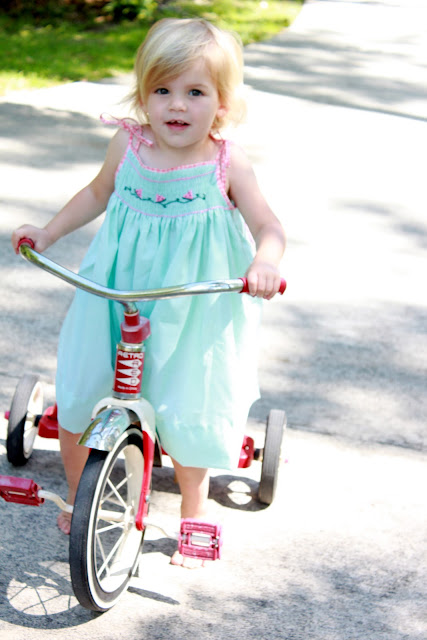Natalie's bishop dress. My first smocked garment.
I was hooked! I made Natalie and Caroline matching dresses for our family beach trip.
and this little sundress for Natalie.
I loved this little sundress and I still love it because she can still wear it as a top 2 years later!
I loved this dress so much that I thought I would make her another one. It is really very simple, the only time consuming thing is the smocking, which took me two nights.
I cut a rectangle of fabric three times my desired finished width by my desired length plus 3 inches (for the hem). So, I wanted the finished width to be 14"and the length to be 20", so I cut it 42" wide and 23" long. Also since this fabric is a gingham, I needed to be careful and make sure that the top of the dress was cut in a straight line following a row of gingham. If I had not done this the pleating would look wavy once it was pleated. You have to do this with any fabric that has an obvious repeat print like a stripe, polka dot, or gingham.
I rolled the fabric onto a dowel rod, being sure to keep all the wrinkles out and the top edge even.
Here is a little tip...use a glue stick to put a little glue on the dowel rod before you start rolling it up. This helps to hold the fabric in place when you start rolling and also helps to keep things smooth.
Then I ran the fabric through my pleater. My pleater is a Read Pleater and was a gift from my parents' neighbor after Natalie was born. She was trying to sell it and when my mother told her I was interested in it she gave it to me as a baby gift!! If you don't have a pleater and aren't sure you want to invest in one (they are pricey), you can have a pleating service do this step for you. There are many pleating services available on the web and often if you have a local store that offers smocking lessons they might also have a pleating service. In fact, I used a pleating service at my local smocking supply store when I made Natalie's bishop dress. It cost me $7. Another option are these iron on transfer dots to mark your fabric and then hand pleat the garment.
Notice that I used blue and orange thread and alternated the colors. This makes it easier to see the pleating rows when you are smocking and alternating the colors eliminates confusion. I also used a heavier duty thread.
Here is another little tip. Keep the top edge of your fabric lined up with the first needle notches on your pleater this will ensure that your pleated rows will be even.
Then I smocked watermelons on the dress. After I was finished I blocked it, I just steamed it with my iron. I marked the center and then used a water soluble marker to mark where I wanted the arm holes.
I used a tiny zig-zag stitch and stitched just inside the line and then cut away the excess.
Then I cut a rectangle for the back that was 20" wide by 23" long. I gathered up the top cut arm holes to match the front. Then I made some skinny bias tape. I used a 1/2" bias tape maker. Here is a great link for making your own bias tape. Then I sewed the bias across the top of both the front and the back.
Then I sewed the sides together and sewed bias tape around the arm holes leaving 16" on each side to tie for straps. Then I hand sewed a 3" hem that can be let down as she gets bigger.














Very well explained. Beautifully smocked.
ReplyDelete